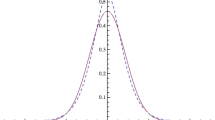Abstract
We consider an equilibrium model à la Kyle–Back for a defaultable claim issued by a given firm. In such a market the insider observes continuously in time the value of the firm, which is unobservable by the market makers. Using the construction in Campi et al. (http://hal.archives-ouvertes.fr/hal-00534273/en/, 2011) of a dynamic three-dimensional Bessel bridge, we provide the equilibrium price and the insider’s optimal strategy. As in Campi and Çetin (Finance Stoch. 11:591–602, 2007), the information released by the insider while trading optimally makes the default time predictable in the market’s view at the equilibrium. We conclude the paper by comparing the insider’s expected profits in the static and dynamic private information case. We also compute explicitly the value of the insider’s information in the special cases of a defaultable stock and a bond.
Similar content being viewed by others
Notes
This rational pricing rule corresponds to perfect competition among the risk-neutral market makers.
References
Back, K.: Insider trading in continuous time. Rev. Financ. Stud. 5, 387–409 (1992)
Back, K., Pedersen, H.: Long-lived information and intraday patterns. J. Financ. Mark. 1, 385–402 (1998)
Campi, L., Çetin, U.: Insider trading in an equilibrium model with default: A passage from reduced form to structural modeling. Finance Stoch. 11, 591–602 (2007)
Campi, L., Çetin, U., Danilova, A.: Dynamic Markov bridges motivated by models of insider trading. Stoch. Process. Appl. 121, 534–567 (2011)
Campi, L., Çetin, U., Danilova, A.: An explicit construction of a dynamic Bessel bridge of dimension 3. Preprint, available at http://hal.archives-ouvertes.fr/hal-00534273/en/ (2011)
Cho, K.-H.: Continuous auctions and insider trading: uniqueness and risk aversion. Finance Stoch. 7, 47–71 (2003)
Guo, X., Jarrow, R.A., Lin, H.: Distressed debt prices and recovery rate estimation. Rev. Deriv. Res. 11(3), 171–204 (2009)
Mansuy, R., Yor, M.: Random Times and Enlargements of Filtrations in a Brownian Setting. Springer, Berlin (2006)
Revuz, D., Yor, M.: Continuous Martingales and Brownian Motion, 3rd revised edn. Springer, Berlin (1999)
Wu, C.-T.: Construction of Brownian motions in enlarged filtrations and their role in mathematical models of insider trading. Ph.D. Thesis, Humboldt University, Berlin (1999). http://edoc.hu-berlin.de/dissertationen/mathe/wu-ching-tang/PDF/Wu.pdf
Acknowledgements
We would like to thank two anonymous referees for their suggestions which have significantly improved the paper. This research has benefited from the support of the “Chair Les Particuliers Face aux Risques,” Fondation du Risque (Groupama-ENSAE-Dauphine), the GIP-ANR “Croyances” project as well as from the “Chaire Risque de crédit,” Fédération Bancaire Française, of the Europlace Institute of Finance. Part of this research has been done when the second author was visiting Evry University during September 2008.
Author information
Authors and Affiliations
Corresponding author
Appendix
Appendix
Lemma 5.1
Suppose that h is a nondecreasing right-continuous function with at most exponential growth. Let
and let (ξ n ) n≥1 be a convergent sequence such that lim n→∞ H(t n ,ξ n )=a for some a in the range of h or in the interval (inf x h(x),sup x h(x)) and for some sequence (t n ) n≥1⊆[0,1) converging to 1. Then
where
Proof
Suppose that \(\lim_{n \rightarrow \infty}\xi_{n}<X^{a}_{{\min}}\). Then there exists some ξ such that we have \(\lim_{n \rightarrow \infty}\xi_{n}<\xi<X^{a}_{{\min}}\). Since H is nondecreasing in x, one has
which is a contradiction. Similarly, we obtain that \(\lim_{n \rightarrow \infty }\xi_{n}\leq X^{a}_{{\max}}\). □
Rights and permissions
About this article
Cite this article
Campi, L., Çetin, U. & Danilova, A. Equilibrium model with default and dynamic insider information. Finance Stoch 17, 565–585 (2013). https://doi.org/10.1007/s00780-012-0196-x
Received:
Accepted:
Published:
Issue Date:
DOI: https://doi.org/10.1007/s00780-012-0196-x




